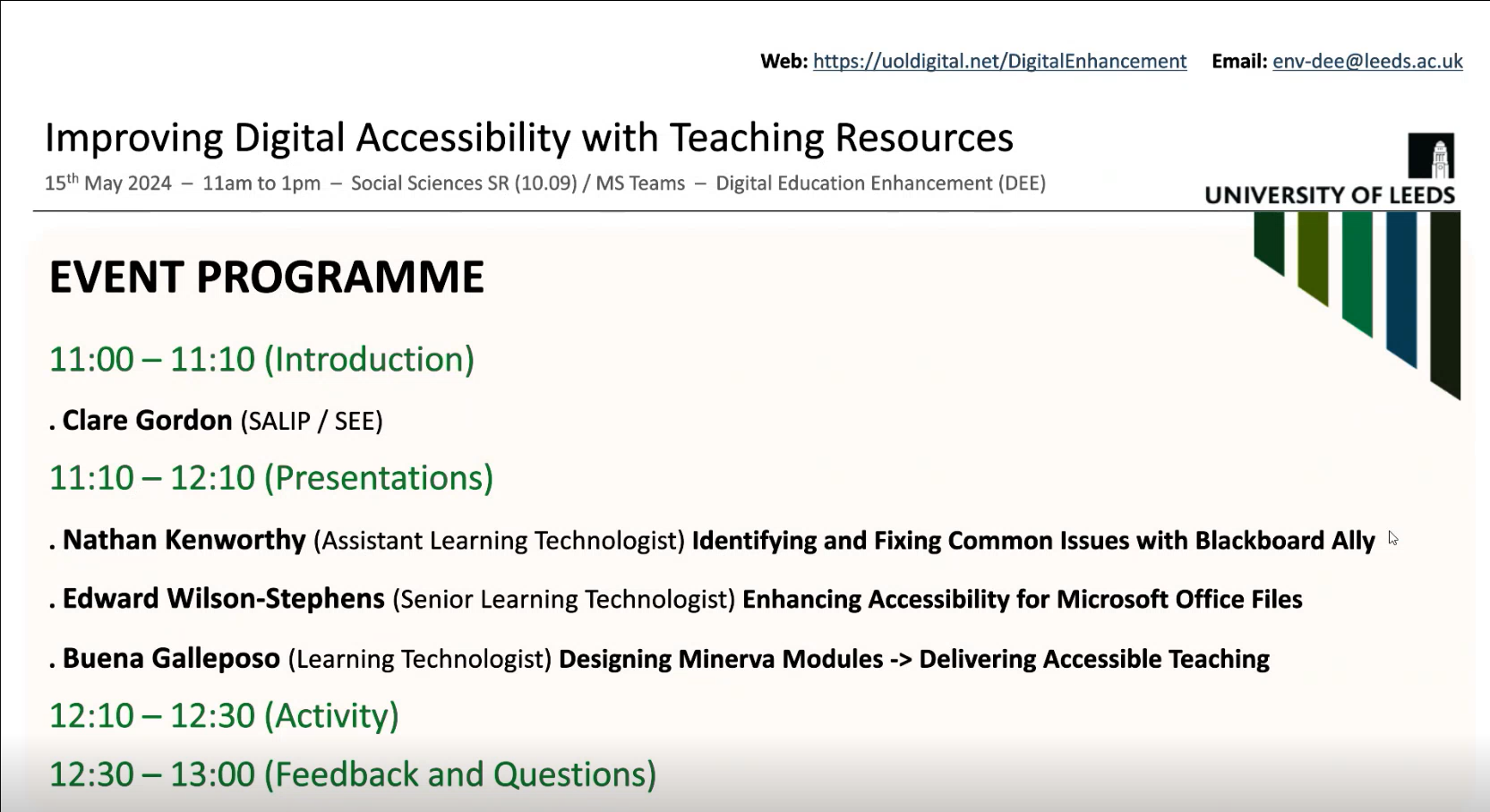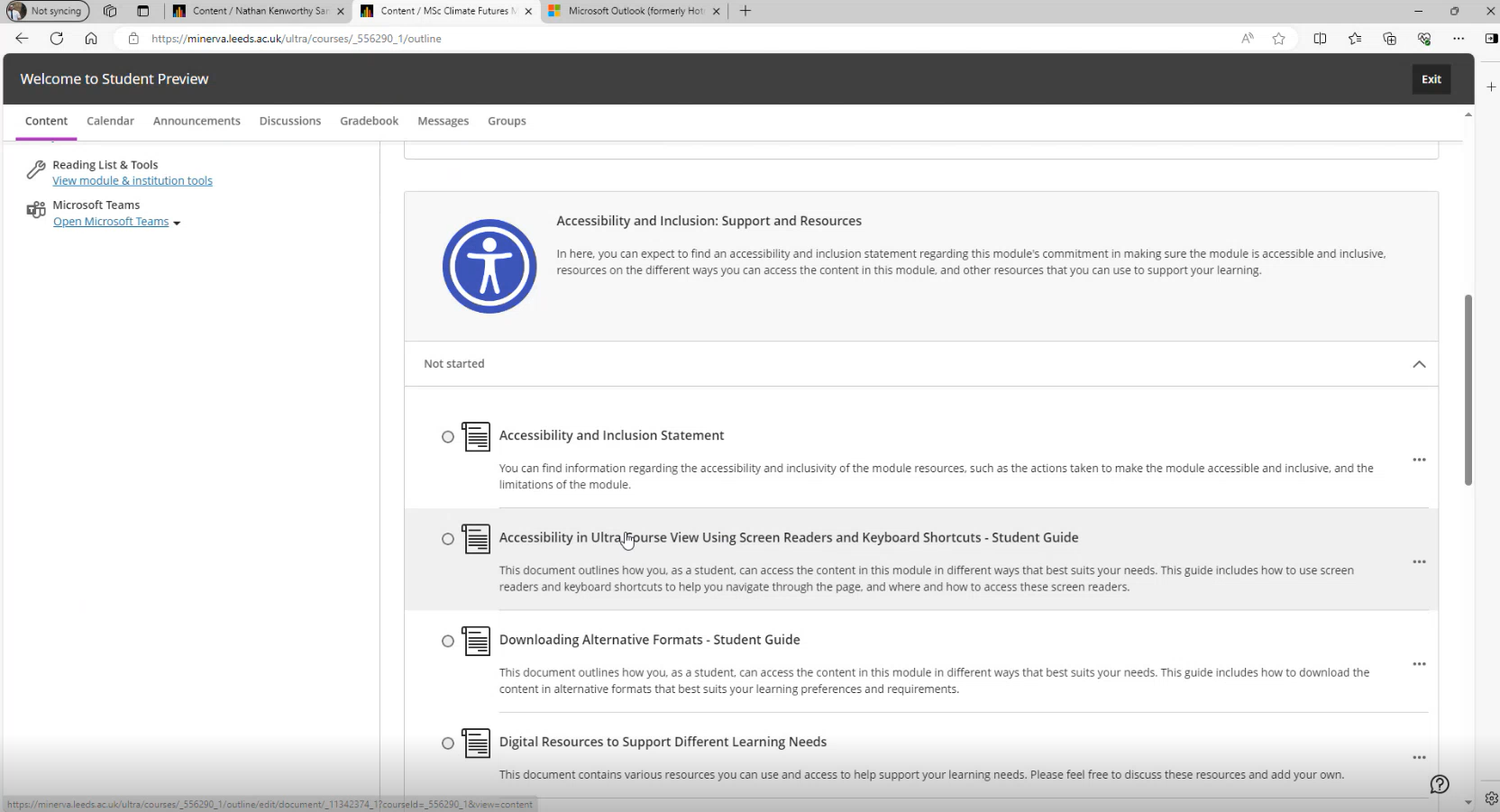Global Accessibility Awareness Day in the Faculty of Environment
This year for Global Accessibility Awareness Day, our team took a holistic approach - going beyond ensuring accessible documents to designing inclusive overall learning experiences. We began with an introduction highlighting digital accessibility's significance in higher ed and a Blackboard Ally demo to cover the basics. Building on that foundation, the core discussion centred around empowering staff to design inclusive Minerva (VLE) module experiences for effective delivery of accessible content. While accessible files are crucial, if students cannot easily navigate to find that material within the module setup, the accessibility is negated. Strategies covered included leveraging pre-built folders, clear labelling conventions, orientation guidance, and consistent formatting across modules. The key takeaway: true accessibility requires holistic learning environment design beyond just meeting technical document criteria.
Moving on from GAAD 2023
To celebrate last year's Global Accessibility Awareness Day, our team held an introductory drop-in event raising awareness about digital accessibility for teaching staff. We provided video tutorials, tip sheets, and hands-on Blackboard Ally guidance for improving course material accessibility - an excellent first step embedding these practices.
Last year focused primarily on 'fixing' issues through Ally and other accessibility guidelines. We shared crib sheets for captions, Microsoft tools, video walkthroughs and template files throughout that week. Reflecting back, this event served as an excellent catalyst for advancing ongoing dialogue and efforts in digital accessibility within the Faculty of Environment. Here, we learned that technical checklists and guidelines for PDFs, PowerPoint, and other materials are great starting points for ensuring accessibility.
GAAD 2024
This year, we followed a more holistic approach to digital accessibility to push the conversation further and challenge the faculty to think beyond just checking boxes on an accessibility checklist. It is crucial that we also design our courses and structure our virtual learning environments (VLEs) - our Minerva modules, to allow these accessible contents to be effectively delivered to students. We wanted our staff to think about how accessibility and module areas work together in practice; it's great to have a screen reader-friendly PDF but the design of module areas needs to be effective so that students can easily locate and access the right materials.

Prior to this year’s event, we shared foundational materials covering an introduction to digital accessibility and how to create accessible digital content using Blackboard Ally and Microsoft Office (these materials can be found in the EdExE - Educational Excellence in Environment - Teams channel). This included an accessible PowerPoint template which featured accessibly designed master layouts as well as slides with instructions on how to maintain an accessible design approach whilst creating slide decks for teaching.
Unlike last year's event which was a more self-directed drop-in session, this year's event was structured as a series of talks, tutorials, and show-and-tell sessions. First, Clare Gordon - School Academic Leads for Inclusive Pedagogies (SALIP) for the School of Earth and Environment - gave a compelling introduction to the significance of accessible practices in higher education. This was followed by a live demonstration of how to use Blackboard Ally to enhance the accessibility of module content by Assistant Learning Technologist, Nathan Kenworthy. Nathan’s demonstration intended to support those new to accessibility practices.

Enhancing Minerva Modules
From there, the event focused on discussing how we can enhance our Minerva modules in a way that fosters a more accessible learning experience for our students. To get the conversation started, we introduced the attendees to a mock module developed by our team, highlighting strategies like:
- Using pre-built folder structure and content areas as intended (e.g., putting the week 5 lecture materials under the “Lecture Materials” folder under the heading, “Week 5”).
- Clearly labelling all files, folders, and content.
- Writing straightforward instructions to help students easily locate materials.
- Maintaining consistency from week-to-week, and if possible, in all the modules across the programme, to allow students to build familiarity.

The key takeaway from this demonstration was that there are approaches to accessibility that work alongside quantitative measures like Ally scores. For instance, a course may be perfectly accessible from a technical standpoint, meeting all the accessibility requirements outlined in the Web Content Accessibility Guidelines (WCAG). However, if that same course is confusing for students, and where materials are disorganised, sections are haphazardly labelled, and weekly content is scattered inconsistently, then the learning experience becomes fundamentally inaccessible to students. Additionally, creating an inconsistent student experience by hosting module content in different places can be a significant barrier. As such, no amount of green Ally checkboxes can compensate for the frustration and barriers created by poor use of the virtual learning environment.
What can we learn from this event?
From our event, we learned that accessibility checklists and guidelines provide an amazing baseline for accessibility, but they are not the destination. A truly accessible course demands thoughtful instructional design in how the materials are structured, packaged, and delivered, just as much as it requires technically accessible documents. An accessible PDF trapped in a labyrinth is as useful as a Netflix subscription riddled with never-ending adverts. The materials may meet the standards, but their intended impact is rendered null and void when the delivery fails the learner experience. Remember: Accessibility is a holistic practice requiring technical rigour and effective delivery.
On that note, these perspectives resonated strongly with our faculty attendees. There was widespread acknowledgement that truly accessible learning experiences require not just technically accessible documents, but cohesive delivery as well. Yet, participants also raised the valid concern that implementing this holistic accessibility mindset is ideal but also extremely time-consuming, especially as some staff may already be stretched thin across a multitude of responsibilities. While they were convinced of the event’s message, finding the capacity to restructure and reevaluate the delivery of their content felt impossible.
As such, it is important that we reflect on how we can better resource and support our academic staff in executing truly accessible education. What services, tools, or process improvements could we provide to allow our academics to reallocate their time to focus on more crucial work like accessibility? How can we ease implementation barriers so true accessible education is no longer just an ideal but also a reality?
Creating an accessible education, may it be through digital means or otherwise, is a responsibility shared by every member of the University community. We must all reflect on the roadblocks and contribute our resources to ensure that accessibility is integrated into the core of the student experience.
Edward Wilson-Stephens, Senior Learning Technologist
Buena Jill Galleposo, Learning Technologist, Faculty of Environment
